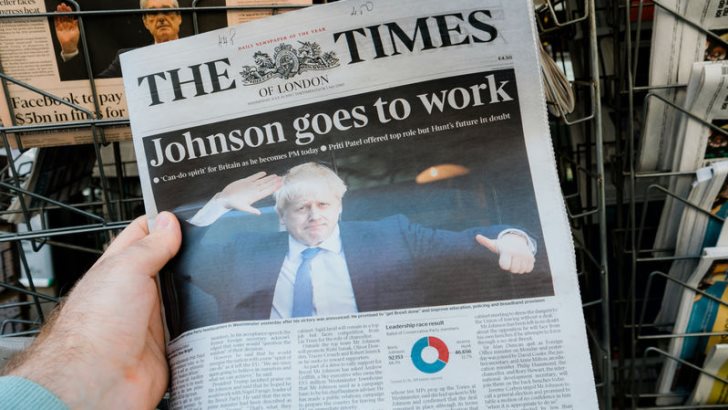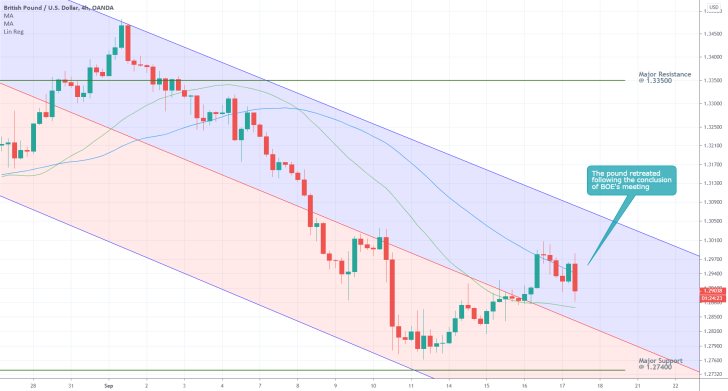
The Monetary Policy Committee (MPC) of the Bank of England expectedly decided to maintain the Official Bank Rate unchanged at 0.10 per cent.
The Committee vowed to preserve a loose monetary policy stance in the foreseeable future until it receives clear indications that the economy is moving towards solid employment gains complemented by robust inflationary pressures nearing 2 per cent.
Moreover, the MPC decided to follow global trends set by other central banks by refraining from scaling up its underlying asset purchase facility at the present moment. The BOE will therefore continue to purchase bonds and other treasuries at the same pace, with the target remaining unchanged at £750 billion.
Arguably, the most important takeaway from BOE's September meeting is encapsulated by the Bank's current stance on the ongoing Brexit negotiations.
As it was revealed in its statement, the MPC continues to build all of its economic projections based on the assumption that the UK manages to smoothly negotiate a trade deal with the EU before the final Brexit deadline, which expires on 1 January 2021.
Yet, recent escalations of tensions between London and Brussels threaten this scenario and highlight the tentative nature of the economic recovery in Britain. All can change in an instant for the BOE, in case that Boris Johnson and the British hardliners fail to reconcile their differences with their European partners.
"The outlook for the economy remains unusually uncertain. The MPC’s central projections in the August Monetary Policy Report assumed that the direct impact of Covid-19 on the economy would dissipate gradually. They were also conditioned on the assumption of an immediate, orderly move to a comprehensive free trade agreement with the European Union on 1 January 2021."
The nature of the uncertainty that currently looms over the recuperating British economy triggered an interim selloff of the sterling. As can be seen on the 4H chart below, the GBPUSD sunk below the 50-day MA (in blue).
The pair, however, continues to be trading above the 30-day MA (in green), which serves as a floating support. The GBPUSD is currently establishing a new downswing, as demonstrated by the downwards sloping regression channel.
In addition to the 30-day MA, the middle line of the channel represents another prominent support. The price action could yet rebound from either of the two.
If, however, the price action penetrates below the two, then the next target level for the emerging downtrend will be encapsulated by the major support at 1.27400.

Trendsharks Premium
Gold is undergoing a correction, as investors take profits to offset losses from falling stock prices, impacting their margins. However, we anticipate a renewed wave of [...]
The Swiss stock market index is mirroring its global counterparts, such as Germany 40 and US100, experiencing a sharp decline following the announcement of new [...]
We’re analyzing the weekly chart to grasp the broader market trend. Over the past three years, the US30 index has surged by 17,000 points, often resembling a nearly straight [...]
Over the past week, the DAX has experienced a sharp decline, plunging by an astonishing 3,400 points. This downward movement is not isolated, as its international counterparts, such as the UK100 and US100, are also facing significant [...]
EURUSD recently formed a double top at 1.0930, signaling a potential trend reversal, and has since begun a correction. After a 600-pip rally since early March, a pullback at this stage is both expected and healthy. Given these conditions, we are placing a [...]
Since early March, EURJPY has surged nearly 1,000 pips, providing us with several excellent trading opportunities. However, as the rally matures, many early buyers are beginning to take profits, leading to a noticeable slowdown in the uptrend. On Friday, the pair formed a [...]
The AUDJPY currency pair continues to be dominated by bullish momentum, as multiple golden cross patterns reaffirm the strength of the ongoing uptrend. Despite this, we are witnessing a much-needed [...]
The EURAUD currency pair appears to be undergoing a trend reversal, signaling a potential shift in market direction. A notable technical development is the formation of a Death Cross on the chart, a widely recognized bearish indicator that typically suggests a [...]
After securing an impressive 200-pip profit last week, the EURJPY currency pair is now undergoing a southward correction, retracing some of its recent gains. Despite this temporary pullback, the Golden Cross remains intact, reinforcing our view that the overall trend continues to be [...]
The appearance of a Golden Cross in Silver strengthens our analysis that the metal is currently in a strong uptrend, indicating further bullish momentum in the market. This technical pattern, where the short-term moving average crosses above the [...]
This trade presents a considerable level of risk and can be classified as an opportunistic move based on recent price action. The GBPUSD currency pair has experienced a substantial bullish rally, surging by nearly 500 pips in a strong upward movement. However, after this extended period of appreciation, the pair is showing signs of a potential [...]
The anticipated Death Cross on the SMI20 appears to be failing as price finds strong support at the 23% Fibonacci retracement level. After testing this area, the index has shown bullish strength, printing several large green candles, signaling an increase in [...]
A Golden Cross has just appeared on the USDJPY chart, signaling a potential bullish move. This technical pattern occurs when the 20 period moving average crosses above the 60 period moving average, a widely recognized indication of increasing [...]
After 2 months of a down trend, we finally see some indications of price recovery for Oil. The golden cross, a historic buy signal, supports this [...]
For the past month, the German DAX40 has experienced a remarkable 10% surge, reflecting strong bullish momentum. Despite ongoing market volatility and frequent pullbacks, every dip continues to attract fresh buyers, reinforcing the [...]
Oil continues its downward trajectory, despite occasional pullbacks. The overall trend remains bearish, reinforced by multiple Death Cross patterns, a classic sell signal indicating further weakness. Adding to this bearish outlook, the critical [...]
Over the past few days, gold has experienced a sharp decline of more than $100. This downturn can be attributed in part to traders securing profits to manage their margins, which are under strain due to the significant drop in major indices. Currently, gold has fallen below the [...]
The NASDAQ 100 index is showing strong bullish momentum, as evidenced by the formation of a Golden Cross on the chart. This classic buy signal occurs when the short moving average crosses above the long term moving average, suggesting that upward momentum is [...]
The EURAUD currency pair has encountered a significant resistance level, failing to break above the critical 61% Fibonacci retracement level. This suggests that bullish momentum is weakening, reinforcing the case for a potential downward move. Given this technical setup, we favor entering a [...]
The UK100 is experiencing a remarkable rally! Over the past few weeks, the British stock market index has surged nearly 800 points. Each minor dip has attracted more buyers, fueling the bullish momentum. However, since last week, we’ve observed a slight [...]




















